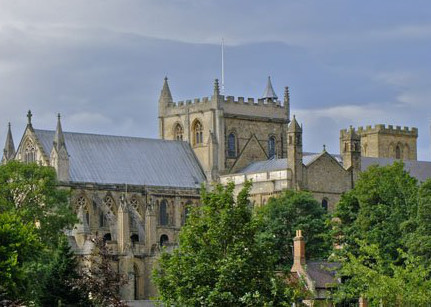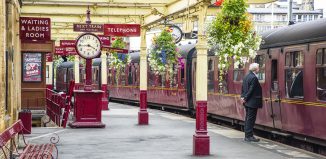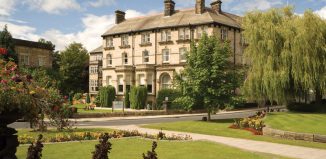Ripon
Angharad Moran
‘Stay awhile amid its ancient charms,’ is the polite, old-fashioned invitation on the signs that welcome visitors to Ripon. It’s an understated greeting that neatly sums up the subtle pleasures of this north Yorkshire city. With just 16,000 inhabitants, its joys are necessarily small scale; those ‘ancient charms’ are tucked away among the winding streets and buildings of old weathered brick. Abandoned by the railway 50 years ago and by-passed by the motorway, Ripon can feel tucked away, but it’s all the better for it.
Somehow, this compact city packs in a cathedral, a market place that Daniel Defoe insisted was ‘the finest and most beautiful square that is to be seen of its kind in England,’ literary ties to Lewis Carroll and Wilfred Owen, three impressive little museums, three rivers and the most northerly stretch of canal in England.
At Ripon’s heart, the Cathedral of St. Peter and St. Wilfrid is not vast, but still dominates the skyline. Founded by St Wilfrid, it was dedicated in 672 AD, although it has been rebuilt four times since. Unfinished pillars and non-matching arches in the nave show where work stopped during the Reformation. The oldest part is the crypt, built with stones probably salvaged from Roman ruins. It is one of only two Saxon crypts in the country.
Blue robed guides will direct you to the best bits, such as the splendid grotesques carved on pillars and corbels, or the cathedral’s misericords (see side panel). One of these extraordinary medieval carvings depicting scenes of nature and wildlife on the choir stalls is thought to have provided the inspiration for Lewis Carroll’s white rabbit.
Bringing the history of Ripon right up to date are 39 tapestry cushions lining 50 yards of the nave. In keeping with the cathedral’s taste for the quirky, the embroiderers included Tibetan nuns and a former German prisoner of war, and the secular subjects the cushion covers depict even include the logos of the town’s supermarkets!
Outside the great West front, cobbled Kirkgate has the best stretch of independent shopping and eating in town and leads to the Market Square. This has been at the centre of the city since the 12th century and was laid by the Archbishop of York during a period of prosperity. The right to hold a fair was first granted to Ripon in 1108 and a general market is still held in the square every Thursday. The control of the market was originally in the hands of the Church, and the Corporation levied a ‘corn-toll’ on trade in the Corn Market. The rights to the market were obtained in 1880 for the sum of £1,500. The opening of the Corn Market was signalled by the Ripon Bellman, and although the Corn Market has long since gone, the city’s Bellman still rings his bell at 11 o’clock each Thursday to officially open the market.
Around the square, there’s a splendid 18th century town hall, some fine medieval and Georgian shop fronts and the whitewashed and brass-plated Unicorn Hotel (now a pub). In the 17th century it was a prominent coaching inn, where for a time one Thomas Crudd was employed. He was known for having a nose and chin so long that he could hold a coin between the two. He would perform the trick for anyone who lent him a coin, which naturally he kept.
At the south east corner of the square sits a wooden ‘cabman’s shelter’ built for the hansom cab drivers in the hope that if they were given shelter and a mug of cocoa they might stay out of the local public houses. Some hope – local historians have noted that although the city was only home to around 6,000 residents at this time, it had an astonishing 37 inns and 16 beer houses to choose from.
More nobly, in the centre of the Market Place stands a 90-foot high obelisk that was designed by Nicholas Hawksmoor and built in 1703 to replace an earlier Market Cross. It was later repaired and remodelled in 1781 by William Aislabie, who served as an MP for Ripon for 60 years. Every evening at 9pm the city’s official Hornblower comes to the obelisk to sound the ‘Setting of the Watch’ and assure the residents that they are in safekeeping for the night – a ritual that has been maintained for over 1,000 years.
From the Market Square, drop down the hill via the Cathedral graveyard to cross the river Skell and find the canal basin. Now a peaceful spot, this was once a bustling dock in the 18th century, when it was used for the transportation of goods to Hull and beyond. Today, all that’s long gone, along with the mills that made Ripon a major medieval textile centre, but now the canal offers a pleasant towpath walk out to Ripon Racecourse on the edge of town.
Known as the Garden Racecourse, it has a truly festive feel on race days, with flower-filled borders, a pretty tree-lined parade ring and a working bandstand. Take a picnic up to the grassy knoll above the finishing straight to watch your horse romp home, or imagine the scene in 1723 when nine women ‘dressed in drawers, waistcoats and jockey caps’ took part in one of the earliest recorded ladies’ races, much to the consternation of the local worthies.
It seems that maintaining proper behaviour is a bit of a theme in Ripon. Its trio of free museums are known as the Law and Order Museums. You can visit all three in an afternoon, beginning at the small 19th century Courthouse Museum, which features a tiny, wood-panelled, old Court Room complete with dock, witness box, public gallery and awning that protected prisoners from a pelting as they emerged from the cells. All were still in use as Ripon’s Magistrates Court until 1998.
The Police and Prison Museum in St Marygate offers a sobering smack of justice. Chains, handcuffs, truncheons and confiscated items like a razor blade embedded in a toothbrush handle are displayed in a series of old cells. Turn the crank handle, climb the treadmill and imagine how it would have felt for the inmates when the cell door slammed behind them and they were alone in a cold, bare, lonely prison cell with a slop bucket.
The saddest of the trio is the Workhouse Museum in Allhallowgate, which was the end of the line for the poor and destitute until 1930. View the tin baths with the authentic reek of carbolic soap, step inside the stark cells, cringe at the restraining chair and the diet of bread and gruel. It’s a story of cruelty and hardship, and a reality check of attitudes towards society’s losers.
West of the Market Place, on Park Street, it’s well worth taking the opportunity to pop into the Spa Baths. The spa was Ripon’s attempt to follow Harrogate in the health spa craze. With no useable sulphur spring, the water had to be pumped from four miles away and by the time the baths were completed in 1905, the fashion for ‘taking the waters’ was waning and Ripon Spa was doomed. Happily, the ornate Burmontoft tiles and stained glass survived.
The Spa Gardens are a proper English municipal park with clipped lawns, immaculately tended flowerbeds in a riot of colours. There are band concerts on summer Sunday afternoons and tennis, bowls, a putting green and crazy golf. The Grade II listed war memorial here – a plinth topped with the bronze head of a soldier – is a reminder not just of Ripon’s dead in two world wars, but of its role as Northern Command Depot with a vast army camp of 30,000 soldiers.
Among them, in 1918, was the great war poet Wilfrid Owen, recovering from shell-shock. Owen avoided the worst of camp life by renting a little riverside cottage at 24 Borrage Lane. Here he wrote Futility and Strange Meeting. It’s said he spent his 25th birthday quietly in Ripon Cathedral. Then it was back to the front. He was awarded the Military Cross for gallantry but on November 4th, he was killed, shot in the head, one week before the Armistice.
Other notable Ripon residents include John Aislabie, who, like his son William, once served as Ripon’s Conservative MP. In 1720 while Chancellor of the Exchequor he was implicated in the South Sea Bubble farrago. Expelled from Parliament and banned from ever holding public office, Aislabie devoted the next 22 years to transforming the wild and wooded valley he had inherited at nearby Studley Royal into a spectacular garden. The Water Garden and the adjoining ruins of the 12th century Fountains Abbey, combine to make an unmissable local attraction that is a designated UNESCO World Heritage Site.
But back to Ripon for a final, charming quirk – the pyramid in Sharrow churchyard. Beneath lies Charles Piazzi Smyth, Astronomer Royal for Scotland, pioneering Egyptologist and discredited pyramidologist. One thesis was that the ‘pyramid inch’ was a measurement handed down by God. Retiring to Ripon for its mild climate, he died in 1900 with his last scheme unfulfilled: a camera that would record and survive the Day of Judgement, an event which he had unsuccessfully predicted for a succession of dates.








